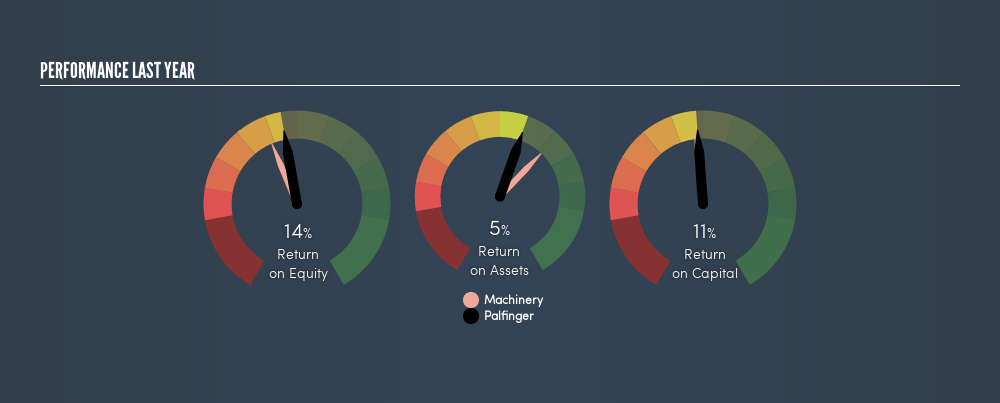Is Palfinger AG's (VIE:PAL) Capital Allocation Ability Worth Your Time?

Want to participate in a short research study? Help shape the future of investing tools and you could win a $250 gift card!
Today we'll look at Palfinger AG (VIE:PAL) and reflect on its potential as an investment. Specifically, we're going to calculate its Return On Capital Employed (ROCE), in the hopes of getting some insight into the business.
First up, we'll look at what ROCE is and how we calculate it. Next, we'll compare it to others in its industry. Last but not least, we'll look at what impact its current liabilities have on its ROCE.
What is Return On Capital Employed (ROCE)?
ROCE is a measure of a company's yearly pre-tax profit (its return), relative to the capital employed in the business. All else being equal, a better business will have a higher ROCE. In brief, it is a useful tool, but it is not without drawbacks. Author Edwin Whiting says to be careful when comparing the ROCE of different businesses, since 'No two businesses are exactly alike.'
So, How Do We Calculate ROCE?
Analysts use this formula to calculate return on capital employed:
Return on Capital Employed = Earnings Before Interest and Tax (EBIT) ÷ (Total Assets - Current Liabilities)
Or for Palfinger:
0.11 = €128m ÷ (€1.5b - €415m) (Based on the trailing twelve months to March 2019.)
So, Palfinger has an ROCE of 11%.
See our latest analysis for Palfinger
Is Palfinger's ROCE Good?
ROCE can be useful when making comparisons, such as between similar companies. It appears that Palfinger's ROCE is fairly close to the Machinery industry average of 12%. Separate from Palfinger's performance relative to its industry, its ROCE in absolute terms looks satisfactory, and it may be worth researching in more depth.

When considering this metric, keep in mind that it is backwards looking, and not necessarily predictive. ROCE can be misleading for companies in cyclical industries, with returns looking impressive during the boom times, but very weak during the busts. ROCE is, after all, simply a snap shot of a single year. What happens in the future is pretty important for investors, so we have prepared a freereport on analyst forecasts for Palfinger.
Do Palfinger's Current Liabilities Skew Its ROCE?
Current liabilities are short term bills and invoices that need to be paid in 12 months or less. The ROCE equation subtracts current liabilities from capital employed, so a company with a lot of current liabilities appears to have less capital employed, and a higher ROCE than otherwise. To counteract this, we check if a company has high current liabilities, relative to its total assets.
Palfinger has total assets of €1.5b and current liabilities of €415m. Therefore its current liabilities are equivalent to approximately 27% of its total assets. Low current liabilities are not boosting the ROCE too much.
The Bottom Line On Palfinger's ROCE
With that in mind, Palfinger's ROCE appears pretty good. Palfinger shapes up well under this analysis, but it is far from the only business delivering excellent numbers . You might also want to check this freecollection of companies delivering excellent earnings growth.
For those who like to find winning investments this freelist of growing companies with recent insider purchasing, could be just the ticket.
We aim to bring you long-term focused research analysis driven by fundamental data. Note that our analysis may not factor in the latest price-sensitive company announcements or qualitative material.
If you spot an error that warrants correction, please contact the editor at editorial-team@simplywallst.com. This article by Simply Wall St is general in nature. It does not constitute a recommendation to buy or sell any stock, and does not take account of your objectives, or your financial situation. Simply Wall St has no position in the stocks mentioned. Thank you for reading.
About WBAG:PAL
Palfinger
Produces and sells crane and lifting solutions in Austria and internationally.
Undervalued with adequate balance sheet and pays a dividend.
Similar Companies
Market Insights
Community Narratives





